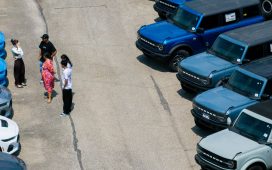A score of top-ranked university students from around the nation received a one-day “crash course” in some of the critical nuclear science and nonproliferation missions of the Department of Energy (DOE) and National Nuclear Security Administration (NNSA) at an event held earlier this month at Lawrence Livermore National Laboratory (LLNL).
Twenty students participated in the June 9 Consortia Workshop on Nuclear Security and Nonproliferation, which was hosted by LLNL and the Nuclear Science and Security Consortium (NSSC), led by the University of California, Berkeley.
“I think the event was very impactful,” said Vladimir Mozin, a physicist in the Lab’s Weapons and Complex Integration Directorate. “We had four experimental stations, each dedicated to a challenging radiation detection problem in the nuclear threat reduction research and development area.
“The students experienced the active R&D areas within Bldg. 262, a unique facility that supports R&D and high-fidelity training activities for various partners. The facility is equipped with a range of radiation materials and sources, including special nuclear materials and neutron and X-ray generators. Our R&D focus includes arms control verification, nuclear material safeguards and search and neutron and gamma-ray diagnostics for emergency response and neutron and X-ray imaging. The students had hands-on experience with state-of-the-art nuclear detection instrumentation in each of these areas.” Mozin added.
The students’ day began with presentations by Lab Director Kim Budil, who gave an overview of LLNL, and Scot Olivier, the point of contact at the Lab for NNSA’s Defense Nuclear Nonproliferation (DNN) R&D, who talked about nuclear threat reduction.
They next participated in four hands-on experimental modules in Bldg. 262 – warhead verification, instructed by LLNL researchers; safeguards, instructed by Oak Ridge National Laboratory researchers; nuclear smuggling, instructed by Los Alamos National Laboratory researchers; and radiological search, instructed by Sandia National Laboratories and LLNL researchers.
“In the warhead verification exercise, we conducted a simulated dismantlement of a Treaty Accountable Item, which is a stand-in for a strategic warhead,” said Phil Kerr, a physicist in LLNL’s Nuclear and Chemical Sciences Division. “Half of the group acted as the host country and the other half acted as arms control inspectors.” Kerr credited Bonnie Canion, a Lab nuclear engineer, with playing a vital role in designing and executing the LLNL exercise.
The 20 students who participated in the workshop were selected on a competitive basis to attend the event, with more than 60 applicants seeking the workshop’s available positions. The students who were selected were chosen from three Defense Nuclear Nonproliferation (DNN) consortia – the NSSC, the Consortium for Monitoring Technology and Verification and the Consortium for Enabling Technologies and Innovation. The consortia and the workshop are funded by NNSA DNN R&D.
“These consortia are dedicated to training a new generation of professionals for nuclear threat reduction and nonproliferation research, which is important for national security, and include the areas of radiation detection, nuclear chemistry, nuclear engineering, data analysis, material studies and others,” Mozin said.
Among those participating were students from Georgia Tech, the University of Tennessee-Knoxville, the University of Wisconsin-Madison, North Carolina State University, the University of Nevada-Las Vegas, Boston University, the University of Florida, the University of Michigan, the University of Illinois-Urbana-Champagne and the University of California, Berkeley.
“These students represent some of the best and brightest intellectual talent in nuclear science and engineering in American universities. We expect many of these students to work at national labs in the near future,” Mozin said.












